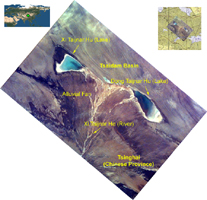
Click on image for larger annotated versionThis image captures the beauty of a major alluvial fan in Tsinghai, a province of China. Tsinghai is located in Northwestern China and its lands are characterized by the high elevation of the Tibetan Plateau. The average elevation is 13,000 ft (4,000 m), but the region visible in the picture is in the Tsaidam Basin, a low-lying area whose lowest point is at an elevation of 8,700 ft. When a highland river flows into an area with a lower elevation, the river's flow causes erosion of sediments from the higher area to the lower area. As this process continues, sediments of earth are deposited in the lower area and a fan-shaped deposit of sediments is formed, with the smallest part of the fan at the high-elevation river inlet. The resulting geographical feature is called an alluvial fan. Here, the inlet river Xi Taijnar He has formed an alluvial fan as its waters flow north into a lower elevation. The build-up of sediment deposits has caused the river to split into several segments that fan out to the northwest and northeast. This splitting up of the river has led to the formation of two major lakes at the edges of the alluvial fan: Xi Taijnar Hu, and Dong Taijnar Hu. Up until the 1940's, the Tsaidam basin was home only to a small assemblage of farmers living in rural areas. Since World War II, however, mines have been founded throughout the region to take advantage of its rich mineral deposits of salt, potash and boron.
This image was taken from the Space Shuttle on January 22, 1997.
Photojournal note:
EarthKAM was formerly known as KidSat. To see images of KidSat, see https://photojournal.jpl.nasa.gov/mission/KidSat .

